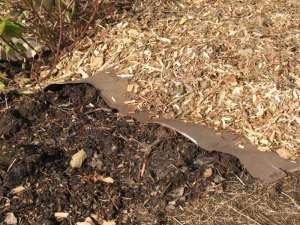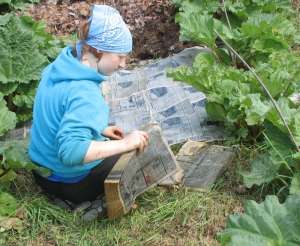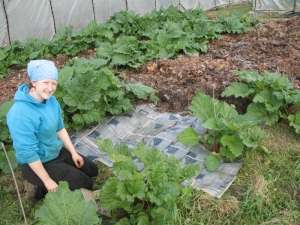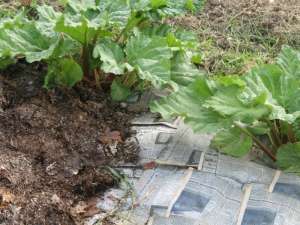![[Snakeroot Organic Farm logo]](pix/sof.gif)
At dawn
Canoe bow waves are quickly lost
on the shoreside
But go on out of sight
on the lake side.
-1986
The constant swish-swish of skis
On a day long ski.
The constant swish-swish of wiper blades
On a day long drive.
-1990
My dog, trotting barefoot
Steps on a garden slug
And thinks
Nothing of it.
-1999
Word spreads quickly
as I approach the pond.
All becomes quiet.
-1997
Hidden in the vines
a large warted cucumber
jumps out of reach.
A toad!
-1997
Delicate puffs
of marshmallow snow
carefully perched
on a branch,
await the trigger of my hat
to melt their way down my back.
-2010
Deep in the tomato jungle
Fruits of yellow, purple and red
Tell of their readiness
To go to market.
-2010
Sugarin' Chores
Snowflakes hurry through my flashlight beam,
As my boots knead new snow with spring mud,
On my nightly Hajj to keep the boil alive,
For as long as possible until the dawn,
To match the power of the flowing sap,
With my meager evaporator and will.
The prize at the finish line are jars of syrup
And Spring.
-2013
|
| ||
|
Combatting |

| |
|
Click on photos to enlarge. In case you are not familiar with it, witchgrass is everpresent in Maine, especially in pastures and fields. It
spreads via rhizomes, or underground stems, which sprout up new spears of grass every few inches.
It can withstand frequent cutting, grazing or mowing and keeps coming back. Like most grasses, it loves cool wet
weather.
 In the above photos, Jill is putting down an overlapping layer of newspapers on
mowed witchgrass in the rhubarb patch in late May, then covering these with leaves. Note how
the newspapers are tucked in under the rhubarb plants, and how much the newspapers are
overlapped. At right, in the same rhubarb patch the following November, you can see why the
newspapers need to be overlapped more than was done in May. The grass was able to find its way
between the papers and emerge, weakened, but ready to catch up. So remember to overlap your
bottom layer quite well. You will note that the second bed over has much better witchgrass
control, since the newspapers were overlapped more.
In the above photos, Jill is putting down an overlapping layer of newspapers on
mowed witchgrass in the rhubarb patch in late May, then covering these with leaves. Note how
the newspapers are tucked in under the rhubarb plants, and how much the newspapers are
overlapped. At right, in the same rhubarb patch the following November, you can see why the
newspapers need to be overlapped more than was done in May. The grass was able to find its way
between the papers and emerge, weakened, but ready to catch up. So remember to overlap your
bottom layer quite well. You will note that the second bed over has much better witchgrass
control, since the newspapers were overlapped more.Another thing we have learned is that, altho the two layer system works well, the fact that the newspaper layer is biodegrading at the same time the witchgrass is trying to poke through it means that sometimes some of the witchgrass will get through. Other times witch grass will be invading from the edges of the mulched patch. This will be evident within a few months, and usually happens only in a few patches here and there. What we have learned to do is to apply the very same method again the following year. The second time, the grass is weaker and sparser, and the mulching even more effective. Once you've killed the witchgrass, it is gone, and won't be coming back. However, it may be forever invading from the edges of your planting, so re-applying the two-layer mulch may become an annual or biennial necessity, at least in certain patches. 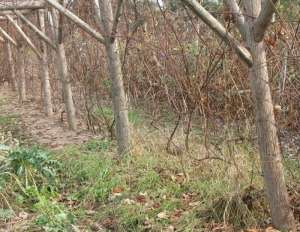 In the photo to the left, you can see the grape arbor as it appeared in early November. The
area in the foreground was mulched with hay-over-newspaper in the spring of the previous
year, and now eighteen months later the grass is well on its way to recovering. Further back, you can see where we
applied the hay-over-newspaper again in the spring of this year, and there is essentially no
witchgrass in that section. Prior to our initial application of the mulch two years ago, the
grass was as thick as I've ever seen it, very much enjoying the leaves-only mulch I had used several
years previously.
In the photo to the left, you can see the grape arbor as it appeared in early November. The
area in the foreground was mulched with hay-over-newspaper in the spring of the previous
year, and now eighteen months later the grass is well on its way to recovering. Further back, you can see where we
applied the hay-over-newspaper again in the spring of this year, and there is essentially no
witchgrass in that section. Prior to our initial application of the mulch two years ago, the
grass was as thick as I've ever seen it, very much enjoying the leaves-only mulch I had used several
years previously.We are always saving pizza boxes, cereal boxes and any cardboard boxes we come across. Mulching the eighty foot long Blackberry Garden this October used up two years worth of cardboard hoarding. Better to use too much than too little. Last year we were fortunate enough to have someone deliver us a van of bundled newspapers, and to date we've used about a third of those. What is our preference for the top layer? Generally whatever is available. During the summer months we are mowing the fields every few weeks so we have a good supply of young hay. Sometimes we have a large pile of wood chips that we make ourselves or is delivered to us. And as you can see in our Using Mulches article, we get pine needles, hay and leaves delivered to us every fall by the good residents of Pittsfield. For each of these we have other uses as well, besides using them for the top layer in our witchgrass battle. So whenever we are applying our two-layer mulch, we look around to see what's in surplus for the top layer. Chips or sawdust as a top layer will last the longest, although for mulching witchgrass it is the bottom layer, not the top layer, which determines effectiveness. Leaves, pine needles and old hay are the second longest lasting, but loose leaves have a tendency to blow off exposing the bottom layer if they are in a windy location. Old hay may itself contain grass seeds (but not witchgrass seeds, for witchgrass produces few if any viable seeds). Young hay and grass clipping are the shortest lived, completely disappearing by the following year. The lack of longevity of the bottom layer is surprising to most people. Newspaper and cardboard when kept moist and in contact with the soil will biodegrade almost completely during the first season with the help of micobes and earthworms. Meanwhile, if applied thickly and overlapped enough, it will have done its job. Then bottom of the top layer will then begin to decompose, slowly feeding your plants. Adding a layer of compost prior to the application of the newspaper or cardboard layer is a way of feeding your plants an even better diet than the decomposing mulch would be. Compared to simple layer of compost on the top of the ground, compost under the mulch will remain moist decomposing and combining with the soil more completely. |
 27 Organic Farm Road, Pittsfield Maine 04967 http://www.snakeroot.net/farm owned and operated by Tom Roberts & Lois Labbe Tom: Tom@snakeroot.net (cell) 207-416-5417 or Lois: Lois@snakeroot.net (cell) 207-416-5418 Gardening for the public since 1995. |
|
|

